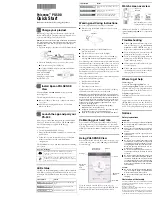
5. Reference
29
5-3. Glossary
DVI (Digital Visual Interface)
A digital flat panel interface. DVI can transmit digital data from the PC directly without loss with the signal
transition method "TMDS". There are two kinds of DVI connectors. One is DVI-D connector for digital
signal input only. The other is DVI-I connector for both digital and analog signal inputs.
DVI DMPM (DVI Digital Monitor Power Management)
The Power management system for the digital interface. The "Monitor ON" status (operation mode) and the
"Active Off" status (power-saving mode) are indispensable for the DVI-DMPM as the monitor's power mode.
Gain Adjustment
Adjusts each color parameter for red, green and blue. The color of the LCD monitor is displayed through the
color filter of the LCD panel. Red, green and blue are the three primary colors. The colors on the monitor are
displayed by combining these three colors. The color tone can change by adjusting the illumination amount
passed through each color's filter.
Gamma
Generally, the relationship that the light intensity values of a monitor change nonlinearly to the input signal
level is called "Gamma Characteristic". On the monitor, low gamma values display the whitish images and
high gamma values display the high contrast images.
HDCP (High-bandwidth Digital Contents Protection)
Digital signal coding system developed to copy-protect the digital contents, such as video, music, etc. This
helpsto transmit the digital contents safely by coding the digital contents sent via DVI terminal on the output
side anddecoding them on the input side.Any digital contents cannot be reproduced if both of the equipments
on the output and input sides are not applicableto HDCP system.
Resolution
The LCD panel consists of a fixed number of pixel elements which are illuminated to form the screen image.
The display panel of this monitor consists of 2560 horizontal pixels and 1600 vertical pixels. At a resolution
of 2560 x 1600, images are displayed as a full screen (1:1).
Temperature
Color Temperature is a method to measure the white color tone, generally indicated in degrees Kelvin. At
high temperatures the white tone appears somewhat blue, while at lower temperatures it appears somewhat
red. Computer monitors generally give best performance at high temperature settings.
5000 K: Slightly reddish white (usually used in print industry)
6500 K: White called daylight color (suited for web browsing)
9300 K: Slightly bluish white (usually used for television)
TMDS (Transition Minimized Differential Signaling)
A signal transition method for the digital interface.
Summary of Contents for COLOREDGE CG303W
Page 41: ...41 Pb Hg Cd Cr VI PBB PBDE SJ T 11363 2006 SJ T 11363 2006...
Page 42: ......














































